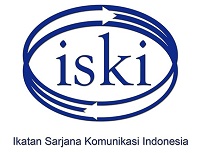Makna Komunikasi Simbolik di Kalangan Pengguna Tato Kota Bandung
Abstract
Keywords
Full Text:
PDF (Bahasa Indonesia)References
Basrowi & Sudikin. 2002. Metode Penelitian Kualitatif: Perspektif Mikro. Surabaya: Insan Cendikian.
Becker, S. Howard. 1997. “Becoming a Marihuana User” Kumpulan teori-teori Sosial dan Fenomenologi sampai Behavioral. Pascasarjana Unpad Bandung.
Black, Reed H. and Edwin O. Haroldsen. 1979. A Taxonomy of Concept in Communication. Hastings House. Publishers. New York. Cassirer, Ernst. 1987. Manusia dan Kebudayaan: Sebuah Esei tentang Manusia. Diterjemahkan oleh Alois A. Nugroho. Jakarta: Gramedia.
Creswell, John W. 1998. Qualitative Inquiry and Research Design: Choosing Among Five Traditions. Sage Publication Inc. USA.
Hayawaka, S.I. 1998. “Simbol-simbol.” Dalam Deddy Mulyana dan Jalaludin Rakhmat. Komunikasi Antarbudaya. Bandung: Remaja Rosdakarya.
Koentjaraningrat. 1985. Kebudayaan, Mentalitas, dan Pembangunan. Jakarta: Gramedia.
Littlejohn, Stephen W. 1996. Theories of Human Communication. Fifth Edition, Belmont California: Eadsworth Publishing Company.
Miller, J.C. 1997. The Body Art Book. New York: Barkeley Books.
Moleong, Lexy J. 2006. Metodologi Penelitian Kualitatif. Bandung: Remaja Rosdakarya.
Mulyana, Deddy. 2000. Ilmu Komunikasi: Suatu Pengantar. Bandung: Remaja Rosdakarya.
_______________. 2003. Metodologi Penelitian Kualitatif: Paradigma Baru Ilmu Komunikasi dan Ilmu Sosial Lainnya. Bandung: Remaja Rosdakarya.
Olong, HA. Kadir. 2006. Tato. Yogyakarta: PT. LKiS Pelangi Aksara.
Phelan, Michael P. And Scott A. Hunt. 1998. Prison Gang Members’s Tatoos as identity Work: The Visual Communication of Moral Careers. University of Kentucky
Schutz, Alfred. 1972. The Phenomenological of The Social World. London: Heinemann Educational Book.
Van Zoest, Aart dan Panuti Sujiman (ed.). 1992 Serba-serbi Semiotika. Jakarta: Gramedia.
Wood, Julia T. 1998. Communications Mosaics. Belmont, California: Wadswort.
Sumber lain:
Gatra. 2001. Tato Mentawai Tertua di Dunia. No. 20. 2 April.
Kompas, Ady Rosa. 2001. ‘Jenderal Tato’. Sabtu, 24 Februari
Rosa, Adi. 1994. Eksistensi Tato sebagai Salah Satu Karya Seni Rupa Tradisional Masyarakat Mentawai. Bandung: Tesis
Institut Teknologi Bandung.
DOI: https://doi.org/10.29313/mediator.v9i1.1140
Refbacks
- There are currently no refbacks.

This work is licensed under a Creative Commons Attribution 4.0 International License























